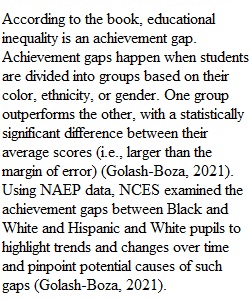


Q Prompt For your discussion board for this week, answer both questions below: 1. Based on your reading in this chapter, what is the top reason for inequality in education today? (Your answer cannot be racism. Pull from something specific in the chapter.) Explain and cite sources to support your claim 2. What do you think we can do to decrease or eradicate educational inequality in the US? (Your answer cannot be to end racism.) You can discuss existing policies, programs or initiatives. You may also propose an innovative idea. Whatever you propose, be sure to back it with references. It gives your recommendation credibility. Note: Do NOT submit incomplete posts. Guidelines • In order to answer this post, each person should click reply to this prompt to create a new thread. • Your initial post should be no less than 250 words, reflecting on the prompt(s) above. • Replies are not required • Write all responses in your own words and cite sources as needed. • Review the DB rubric and video to ensure full credit. • Please post your initial reply no later than 11:59pm on Tuesday, October 11th. • Response posts are due by 11:59pm on Friday, October 14th. Technical Support • Need help using Canvas Discussions? If so, please review the following page: Canvas Resources for Students - Discussions.Links to an external site.
View Related Questions